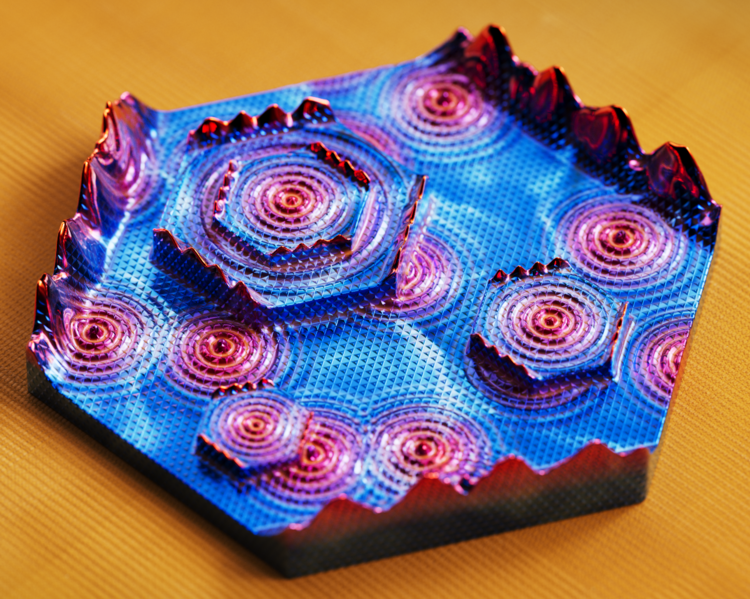Insider’s Brief
- Physicists report on new discoveries in quantum materials that could open up new pathways to quantum devices and electronics.
- Physicists at Princeton say they made a discovery in the realm of quantum materials that could open up new pathways to quantum devices and electronics.
- Image: A representation of data visualization of quantum states of electrons on the surface and edge of grey arsenic crystal. (Credit: Princeton)
According to a news story on the Princeton website, the researchers report they have identified a new quantum effect known as “hybrid topology” in a crystalline material made from arsenic atoms. This discovery, published in the journal Nature recently, could lead to the development of advanced materials and technologies in the rapidly evolving field of quantum science and engineering.
The team, led by M. Zahid Hasan, the Eugene Higgins Professor of Physics at Princeton University, used advanced techniques like scanning tunneling microscopy (STM) and photoemission spectroscopy to uncover and examine this new quantum state. The researchers were taken aback by their investigation. Unlike anything seen before, this state melds two types of quantum behavior—edge states and surface states—into a single, hybridized form. This fusion creates a new state of matter, one that was completely unexpected and not predicted by theoretical models.
The study of topological states of matter, which combines quantum physics with the branch of mathematics known as topology, has become a hotbed of scientific inquiry. Until now, most experiments in this area have focused on compound materials made by combining elements like bismuth (Bi) with others such as selenium (Se). However, the Princeton team’s discovery marks the first time such topological effects have been observed in a material composed solely of arsenic, an element.

“A suitable atomic chemistry and structure design coupled to first-principles theory is the crucial step to make topological insulator’s speculative prediction realistic in a high-temperature setting,” said Hasan. “There are hundreds of quantum materials, and we need both intuition, experience, materials-specific calculations and intense experimental efforts to eventually find the right material for in-depth exploration. And that took us on a decade-long journey of investigating many bismuth-based materials leading to many foundational discoveries.”
The implications of this discovery are significant. Topological materials have been lauded for their unique properties, such as acting as insulators within their bulk while allowing conductivity along their edges or surfaces. This characteristic, stemming from the material’s topological nature, means that electrons can flow unimpeded by defects or irregularities. Such materials are crucial for exploring the deeper mysteries of quantum topology and hold potential for revolutionizing technologies in quantum information science and quantum computing.
More Work Remains
However, before these advanced applications can become a reality, researchers must overcome significant challenges. One major hurdle is finding ways to maintain quantum topological effects at room temperature. Additionally, identifying simple and elemental materials that can host these phenomena—similar to the role silicon plays in conventional electronics—is crucial for practical applications.
The recent findings by Hasan and his team represent a significant step towards addressing these challenges. By demonstrating that arsenic, an elemental solid, can exhibit complex topological phenomena, they have laid the groundwork for future research that could lead to the development of new quantum materials and devices.
The discovery of these new materials and their properties could have societal-level benefits. The identification of elemental solids as platforms for exploring topological materials has already enriched the field, leading to the development of innovative materials and technologies, the researchers report.
Hasan envisions arsenic playing a similar role and serving as a new platform for advances.
“We envision that arsenic, with its unique topology, can serve as a new platform at a similar level for developing novel topological materials and quantum devices that are not currently accessible through existing platforms,” said Hasan. “A new exciting frontier in material science and novel physics awaits!”
This groundbreaking research not only highlights the potential of topological materials in advancing quantum electronics and energy-saving technologies but also opens the door to a host of future research possibilities and applications. As the Princeton team continues to explore the frontiers of topological insulators and seek out novel states of matter, they contribute to a growing body of knowledge that promises to shape the future of quantum science and technology.
For a deep dive into the researchers’ work, please see the journal article in Nature.
For more market insights, check out our latest quantum computing news here.


















